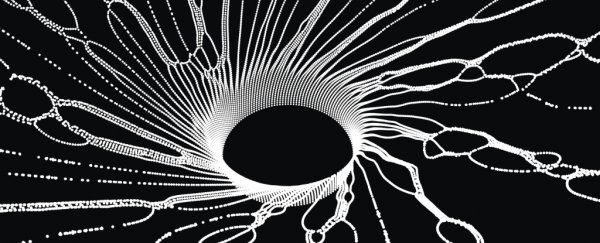How are black holes born? Astrophysicists have theories, but we don't actually know for certain. It could be massive stars quietly imploding with a floompf, or perhaps black holes are born in the explosions of colossal supernovas. New observations now indicate it might indeed be the latter.
In fact, the research suggests that those explosions are so powerful, they can kick the black holes across the galaxy at speeds greater than 70 kilometres per second (43 miles per second).
"This work basically talks about the first observational evidence that you can actually see black holes moving with high velocities in the galaxy and associate it to the kick the black hole system received at birth," astronomer Pikky Atri of Curtin University and the International Centre for Radio Astronomy Research (ICRAR) told ScienceAlert.
And it means there are potentially millions stellar-mass black holes zooming around the galaxy at high speed. The paper, currently available in pre-print, has been accepted into the Monthly Notices of the Royal Astronomical Society.
The study was based on 16 black holes in binary systems. Unless they're actively feeding, we can't actually find black holes, since no detectable electromagnetic radiation can escape their insane gravity. But if they're in a binary pair and actively feeding on the other star, the matter swirling around the black hole gives off powerful X-rays and radio waves.
Once we can see these black hole beacons, we can see how the black hole is behaving. The international team of researchers used this behaviour to try and reconstruct the black hole's history.
"We tracked how these systems were moving in our galaxy - so, figured out their velocities today, moved back in time, and tried to understand what the velocity was of the system when it was born, individually for each of these 16 systems," Atri explained.
"Based on the velocities, you can actually find out if they were born with a supernova explosion, or if the stars just directly collapsed onto themselves without a supernova explosion."
We know that neutron stars can be violently punted out across space at high speeds by their own supernova explosions - this is called a Blaauw kick, or natal kick, and it happens when the supernova explosion is lopsided, resulting in a recoil.
It was unknown if black holes could be kicked in the same way. Hypothetically, they might - and indeed seven black hole x-ray binaries have been previously associated with natal kicks.
The new research has analysed these, as well as nine others, in greater detail, combining measured proper motions, systemic radial velocities, and distances to these systems for the most detailed analysis yet.
The motion of one of these black holes as calculated by the team can be seen in the video below.
The researchers found that 12 of these 16 black hole X-ray binaries did indeed have high velocities and trajectories that indicated a natal kick. That's 75 percent of the sample. If this scales up to the estimated 10 million black holes in the Milky Way, that might mean around 7.5 million high-speed black holes careening out there. And 10 million is a low estimate.
In line with previous theories, these speeding black holes are slower than kicked neutron stars by a factor of about three or four, due to their higher mass. Interestingly, there seemed to be no correlation between black hole mass and velocity, which means we don't yet know if there's a correlation between progenitor star mass and the likelihood of a supernova.
This is a relatively small sample size of black holes, of course. But, according to Atri, it's a step towards building up a larger sample that can help us to understand how stars evolve and die, and give rise to black holes.
"Eventually, all of this will feed into how many black holes we expect in our galaxy, how many black holes that will actually merge to give those gravitational wave detections that LIGO finds," she added.
To continue to build on the research, the team will keep watching the sky. These binary systems aren't always bright - they come and go, transient. So the researchers are hoping to find more of these binary systems to continue building a census of Milky Way black holes, whether speeding or not.
And, in case you're worried right now about a black hole cruising right into our Solar System, you don't really need to panic.
"The closest black hole, we think it's two kiloparsecs away [6,523 light-years]," Atri said.
"It's very, very far away. So there's no chance that we're getting sucked up by any black hole any time soon."
The paper has been accepted into the Monthly Notices of the Royal Astronomical Society, and is available on arXiv.
